|
|
#1
|
||||
|
||||
|
The blank back thread reminded me of a few questions that I have for those of you who have researched these particular aspects of the T206 set.
I always assumed that the lithographs (fronts) were most likely printed first leaving some unfinished (blank backs) for whatever reason. Maybe they were color test sheets or initial runs to test the quality of the cards. Who knows, but some didn't make it to the next step of the process where the backs were printed. I know it's been stated several times on this board that the fronts and backs were both printed at the American Lithograph Co. I'm wondering how "we" know this. Is there documentation or just speculation? I know the famous Ball letter refers to the company, but how do we know that both the fronts and backs were printed at the same place? Wouldn't the lithograph co. only be responsible for printing the lithographs? If they were printed at the same place, then where did the overstrikes come from and how can they be explained? I guess it's possible but I doubt the card backs were printed with the intended distribution factory on the back and then struck again before they left the same place where they were printed. Any thoughts or comments ? I'll admit I don't understand much about this front/back process, but are we positive both the fronts and backs were printed at the same facility? Rob Last edited by caramelcard; 03-09-2010 at 01:06 AM. |
|
#2
|
||||
|
||||
|
Paging Leon Luckey, paging Leon Luckey....
|
|
#3
|
||||
|
||||
|
Hey Dave
I appreciate the call but this is an endeavor for Teddy Z. Ted has studied this quite a bit. Also, a couple other T206 guys could chime in, Brian W., Art M, Joe D (on the printing side)........we are chalk full of guys that take the physical printing to another level. Now, if there is an obscure card or back, then I would be happy to jump in and see if I can add anyything to the discussion. I guess, since we do have quite a few new guys, I can at least show a real T206 proof. I don't think we consider the regular blank backs proofs for obvious reasons....best regards
__________________
Leon Luckey |
|
#4
|
||||
|
||||
|
Robert -
without specifically knowing..... I would believe the fronts were printed first most often.... but not necessarily all of the time. If a press is running and the pressman has backed up all of the 'printed front' sheets it has on hand.... I could easily see the shop putting in virgin stock and continuing the run by printing additional backs. If there is a reasonable expectation that additional cards will be printed - in this instance, it wouldn't make sense to change the press setup to put on fronts. They would just keep running backs. Its also possible that the printer looked to keep a 'backs' inventory (sheets printed with just the backs) - to help if they needed to get out a batch of cards quickly. Printing the fronts first makes the most sense to me, and I would guess it was done most often - but I wouldn't be surprised (especially considering this must have been a huge print project) - if, from time to time the backs were printed first.
__________________
Joe D. |
|
#5
|
||||
|
||||
|
Has anyone ever seen a "blank front" T card with just the back printed to back up the back printed 1st theory?
__________________
I Remember Now. 
|
|
#6
|
||||
|
||||
|
Quote:
but a while back - I think someone showed an uncut sheet of just 'piedmont' backs. no fronts. just going by memory though - I could have it wrong.
__________________
Joe D. |
|
#7
|
||||
|
||||
|
Wouldn't the wet sheet transfers and other oddities we see be a good indicator that the front and backs were printed in the same place?
Leon's "Warhol" being a great example. Last edited by Abravefan11; 03-09-2010 at 07:26 AM. |
|
#8
|
||||
|
||||
|
__________________
T206Resource.com |
|
#9
|
|||
|
|||
|
This is true, a partial uncut sheet of PIEDMONT backs was found some years ago. And, I base my contention that the
backs were printed first on that find. But, you're our resident printer, isn't it common sense that the ONE color process that T206 backs are was printed first ? Then, the more complex 6-color process in printing the fronts followed....on the pre-printed sheets (with backs) ? ? TED Z |
|
#10
|
||||
|
||||
|
Most wet sheet transfers are front images with a wet back transfer. This doesn't prove they were printed in the same place as it could have happened to a preprinted front at location #2.
Leon's card however has a front image mixed in to the reverse with brands distributed by several different factory numbers leading one to conclude all of the printing was done in one place. IMO |
|
#11
|
|||
|
|||
|
This debate can be fun......but, we have beaten this subject to the ground over and over again.
We have presented American Lithographic (ALC) ledger notes on the release dates of various Tobacco brand cards. We have shown many multi-back printings (T206 and Militarymen scrap) that unquestionably indicates that all these cards were printed in New York at ALC from 1909 to 1919. Please use the SEARCH function and type in "American Lithographic" and you will get tons of stuff on this subject. TED Z |
|
#12
|
||||
|
||||
|
Quote:
Ted.... looking at the overall product - (the cards)....... I would say no. Since the Fronts are common (to a variety of backs) - I would think it more logical to print the fronts...... and then as you need certain quantities for certain backs, you back up those sheets with the backs. As far as what is the more difficult part - yes.... the fronts had to be more difficult / but they still had to get done - so I don't see the difficulty as a determining factor as to what went first. But.... if the pressman had the press setup and running for 'backs' and ran out of front sheets to back up.... precisely because of potential difficulty - I could see the pressman continue to run backs on virgin stock (especially knowing the size of the overall order / more cards would be needed). Also.... No doubt these cards were printed over multiple press runs, spanning days, weeks, or months, and you could very easily have had it run on many presses at one time (meaning different pressman / different machinery / all in the same shop). To a point made earlier: As far as why you may find more cards that have a blank back (as opposed to those that have a blank front)..... In general, I think it more unlikely that a cutter would cut down a sheet of just backs. Realize after the press run - there are other processes - and other eyes and hands that go over the product. I could see someone cutting down sheets of just fronts (for themselves or others) - but I have no idea why sheets of backs would be cut down and saved.
__________________
Joe D. Last edited by bijoem; 03-09-2010 at 08:20 AM. Reason: spelling |
|
#13
|
||||
|
||||
|
"We have shown many multi-back printings (T206 and Militarymen scrap) that unquestionably indicates that all these cards were printed in New York at ALC from 1909 to 1919."
Ted, I'm familiar with T80s. How does this indicate the backs were printed at the ALC? |
|
#14
|
||||
|
||||
|
Question for Scot Reader when you get some time:
Can you explain what you mean by this statement from your T206 study? "The backs of most T206 cards identify the factory where they were produced." Thanks! Rob |
|
#15
|
||||
|
||||
|
Why would you find more cards with a blank back rather than a blank front?
My opinion: Because folks would still want to keep a piece of cardboard that still had a baseball player on it. I don't believe folks would want something with only a tobacco advertisement on it and most were probably not taken home as scrap if they were blank fronts. |
|
#16
|
|||
|
|||
|
Regarding your question......
" Ted, I'm familiar with T80s. How does this indicate the backs were printed at the ALC? " We have seen several 460 series T206's (Ford is one card that comes to mind) whose fronts & backs (that are multi- printed scrap) with T80's images printed on them. Tell me Rob, why are you such a skeptic of American Litho. printing all the T-cards from 1909-1919 (except T216's) ? Speaking about T216's, they were printed (most likely in Philadelphia) by the same printing firm that produced most of the Caramel cards. Do you you doubt this, too ? ? Regards, TED Z |
|
#17
|
||||
|
||||
|
Hi Ted,
First, thanks for the info on the Ford card. I wasn't aware there was a T80 back printed over a T206 front. I'm not suggesting that all the fronts of the T cards were not printed at the ALC. I'm also not suggesting that each tobacco co. (piedmont, sweet cap, etc.) printed their own backs. I'm suggesting that it's possible that the backs were printed at a different facility. I do believe the all or most of the backs were printed at the same facility. When we look at cards like Leon's scrap, we see Old Mill over EPDG over Piedmont, but those are all VA distributed cards. I agree that it would make financial sense for the ALC to print both and that it's a strong possibility. I just wanted to see what evidence we had if any. I still don't understand the overstikes. With an issue like T209 color, it seems to me that the actual distribution factory stamped their own fa. number on the cards and not the printing factory. With other caramel and bread issues, we see anonymous and blank backs being produced and stamps and printings applied when the cards arrive in the distribution region. So, it's possible. Rob |
|
#18
|
||||
|
||||
|
I wanted you to post your multiback T206
 I think it is one of the better visual keys to understanding the printing of the cards. I think it is one of the better visual keys to understanding the printing of the cards.
|
|
#19
|
|||
|
|||
|
Regarding Leon's famous multi-overprint scrap, Old Mill and Piedmont are VA Factory # 25....while EPDG is VA Factory # 17......major difference.
This might seem trivial, but trust me it isn't, as the Federal Tobacco Laws back then regulated these various factory's. So, if one was to think that backs were printed at the various factories, Leon's card certainly discredits that idea. Further evidence of American Litho. (ALC) printing the majority of T-cards (BB and Non-Sports) during the 1909-1919 era, is the ALC letter (dated March 1911) that instructs that one BB (T206) and one T80 (Militarymen) be inserted in LENOX, TOLSTOI and UZIT cigarette packs. ![[linked image]](http://i529.photobucket.com/albums/dd339/tz1234zaz/bsweetcaplenoxuzit.jpg) .................................................. ............................................ ![[linked image]](http://i603.photobucket.com/albums/tt113/zanted86/blenoxuzitt80.jpg) Finally, there are 2 overwhelming factors that support my contention that all the American Tobacco Co. (ATC) brand premiums were printed at ALC. (1) James B. Duke of ATC and Joseph Knapp, founder of ALC, were very close friends and business partners. (2) ALC was the foremost lithographic company in America in the late 19th and early 20th Century. TED Z |
|
#20
|
||||
|
||||
|
Here's a scan of the T206 Ford card Ted mentioned. It has a double-struck Tolstoi back (Factory 30, 2nd Dist. NY) and the pink ink layer from the T68 Heroes of History set (Irish Patriot Robert Emmett, and, above him, the decorative aiguillette from the uniform of General Custer).

Last edited by jimonym; 03-09-2010 at 05:45 PM. |
|
#21
|
||||
|
||||
|
Hi Ted,
You made some good points. Thank you. Again, I'm not suggesting that these card backs were printed at the different factories, just that it's possible the backs were printed at a different shop than that of the ALC. Why would the letter instruct ALC to insert the cards into the packs? I thought the insertion into the packs happened at the tobacco factories. As far as James Duke, I'm a nonsports collector and follow a lot of the Duke issues. He had issues where he used other lithography companies. Duke had a lot of friends. Duke issues also used: Giles Company out of NY. Geo Harris and Sons out of Phila. Donaldson Brothers, NY. Schumaker and Ettinger, NY And more. This was at the same time that he was using Knapp's services which at the time was called Knapp & Co. Rob Last edited by caramelcard; 03-09-2010 at 05:56 PM. |
|
#22
|
||||
|
||||
|
I was generally of the persuasion that the card backs were printed by ALC, but after coming across this passage I am now of two minds. It is from the Report of the Commissioner of Corporations on the Tobacco Industry, Part 1 (1909) pages 263-264 (I pasted the passages together for easier reading).
The text is general in its description, but it's not beyond the realm of possibility that since much of the paper packaging was being printed at the tobacco manufacturing facility that the card backs may have been printed there as well. 
|
|
#23
|
||||
|
||||
|
Hi Rob,
Duke wasn't using Knapps services.... He helped him form the ALC and was most likely the silent partner.... Be well Brian |
|
#24
|
||||
|
||||
|
Hi Brian,
In the 1880s, or in 1909? I believe you're talking about when the ALC was formed right? Thanks Jamie for posting that. Rob |
|
#25
|
||||
|
||||
|
My one T206 thingy....for the 1.2 millionth time....By some accounts I show this so often I should have sold it 100x by now.
__________________
Leon Luckey |
|
#26
|
|||
|
|||
|
Leon- as I look at the back of your card carefully I see:
1) Cy Young 2) Piedmont 3) Old Mill (which somebody pointed out was brown) 4) EPDG rightside up 5) EPDG upside down Are those five passes everything, or am I missing something? |
|
#27
|
||||
|
||||
|
It just works for me, what can I say?

|
|
#28
|
||||
|
||||
|
Quote:
This will sound weird but I have actually just let the "print guys" figure this one out. I just stare at it  . I think you might have it correct though... . I think you might have it correct though...
__________________
Leon Luckey |
|
#29
|
|||
|
|||
|
Do you take any hallucinogenics while you stare at it? Come to think of it, you don't need any.

|
|
#30
|
|||
|
|||
|
Regarding your......
1st....."Again, I'm not suggesting that these card backs were printed at the different factories, just that it's possible the backs were printed at a different shop than that of the ALC. " Again, recall Leon's Mullaney scrap card with at least two different Factory backs printed on it. Please explain how this occurred if it wasn't printed at ALC ? Are you suggesting it was printed at two different Factory's ? ? 2nd....." As far as James Duke, I'm a nonsports collector and follow a lot of the Duke issues. He had issues where he used other litho- graphy companies. Duke had a lot of friends. Duke issues also used: Giles Company out of NY. Geo Harris and Sons out of Phila. Donaldson Brothers, NY. Schumaker and Ettinger, NY " These were great lithographic firms in the late 19th Century. By 1902 ALC had bought most of them (with the financial backing of Duke). I, too, have many Non-sports cards from some of these firms. The Geo. Harris & Sons Litho. Co. was exceptionally good. They produced my favorite set of cards....the 1888 N162's and the fabulous A36 (Goodwin Champions) album. 3rd....." Why would the letter instruct ALC to insert the cards into the packs? I thought the insertion into the packs happened at the tobacco factories. " By the Spring of 1911, ALC was running out of their T206 stock. They were beginning to produce their Gold-Bordered cards (T80's, T205's, etc.). So, we can safely assume that they were suggesting that Factory # 30 pair off the remaning T206's with the newly printed T80's in their LENOX and UZIT cigarette packs. TED Z |
|
#31
|
|||
|
|||
|
I have always believed that the T206 cards were printed on the fronts first. Then the sheets were divided up and printed with the different back brands. I believe the finished cards were then shipped to the corresponding tobacco/cigarette brand factories and inserted into the packs/polar bear pouches/etc.
Just cannot imagine the American Lithograph Co. dealing with anything other than the printing. Pretty sure they were not involved with inserting cards into packs. Art |
|
#32
|
|||
|
|||
|
And, adding to what Ted and Art M. have posted, I could never see a tobacco factory dedicating the floor space and storage space for an entire line with workers to the task of printing and cutting the cards in house. It would be much easier to have a couple of workers inserting the individual pre-cut cards, newly arrived from ALC into the packs as they came off the line.
|
|
#33
|
||||
|
||||
|
About the sheet of uncut backs... are we sure this isn't being confused with the sheet of uncut Piedmont boxes that was found? I may be wrong but just cant recall the sheet of uncut backs...
__________________
For information on baseball-related cigarette and tobacco packs, visit www.baseballandtobacco.com. |
|
#34
|
||||
|
||||
|
Quote:
|
|
#35
|
|||
|
|||
|
In a previous post I speculated that ALC printed the boxes, but shipped them in uncut sheet form to the given Factory,
based on the uncut sheet find in North Carolina. What I do not understand about this recurring discussion is that we have pretty well arrived at certain facts where the cards were printed, how they got to the various factories, where these factories were located, and what was done at these factories. We settled all this several times over back in 2006, again in 2007, then again in 2008, and as recent as 2009. But, here we go again, mulling it all over for the umpteenth time. You can check it out by using the SEARCH function....this func- tion is one of the great features on Net54. Simply type in "American Lithographic" or whatever will get you the info that you are looking for. Doesn't any one ever access the Net54 search function, anymore ? TED Z Last edited by tedzan; 03-10-2010 at 05:59 AM. |
|
#36
|
||||
|
||||
|
Based on visual evidence alone, I believe neither the fronts nor the backs were printed first. Maybe when the print run began in 1909, yes one side or the other was printed first, but as the print run progressed and more tobacco brands were added, I think they were printed according to what was needed.
I believe this because some printing mishaps are back specific and some are not. Here are two examples: 1. The Lundgren recently found by Jamie (Blunder19) appears to be a back specific printing mishap - Piedmont 150 Fac.25. Three board members posted that their cards all had this same back. So in this case, I guess one could say that the backs were printed first. This also applies to other printing mishaps in this set as well. 2. The Murr'y printing mishap on the other hand, appears to be a non-specific back mishap since it is found with 4 different backs - Lenox, Sweet Caporal 460, Piedmont 460 and Tolstoi. Please correct me if I'm wrong here, but didn't the Tolstoi brand appear in 1910 and the Lenox brand didn't appear until 1911. I'm going with what I read in "the Monster", but it looks to me that this printing mishap jumped from one print series to the next, which could make one think that the fronts were printed first and the sheets were stored until later needed and then the back advertisements were added. I'm not saying anyone is right or wrong in whatever they believe about the printing process of this set, I'm just pointing out some of the small discoveries that I've made since collecting these cards. Jantz |
|
#37
|
||||
|
||||
|
Quote:
I agree completely. I have to believe the cards were produced in the least expensive, most efficient way possible. Which would mean different methods depending on what was best that hour, that day, or at the time.
__________________
Joe D. |
|
#38
|
|||
|
|||
|
Hi Robert,
I recommend that you download the most recent edition of Inside T206 from Old Cardboard (it's free), which states that the factory designation on the back of T206 cards identifies the factory from which the cards were distributed, not the factory at which the cards were produced. I view all writing as an experiment, and I did my best to correct errors in my initial manuscript as they came to my attention. Scot |
|
#39
|
||||
|
||||
|
Gotcha, Thanks Scot. I'll download the more current version.
Thanks for your hard work on the project. It's very helpful. And thanks Ted for putting up with the repetition. I know you've hashed a lot of this stuff out before. Rob |
|
#40
|
||||
|
||||
|
First off,my apologies for bringing up a subject that has "been beat to death",but after reading this thread over and over,as well as searching the archives on American Lithographic,I still seem to have the same questions that Robert asked about in his original post.
Refering to post #22: "The plants are quite generally equiped with machinery for cutting,folding,labeling,printing,and filling packages of this description". Printing what? This really makes me wonder about the printing of the backs.I completely understand ALC printed the tobacco cards-but are we really so sure about the backs? Leon's Mullaney/Young sure does make you think all of the printing was done at the ALC,but does it exclude all possibility that the backs could have been printed elsewhere?What does the portion of the letter in post#22 that I quoted above mean?What were they printing? Since the backs are only printed in one color,would it be too far fetched to think the factories may have printed the backs on these cards? Another interesting thing I've noticed,is a few things in Mr.Lipset's Encyclopedia of Baseball Cards Volume 3........... T206 (page 55, under Color Varieties) "In a set as wide in scope as T206 there are an endless amount of color variations.Printed in a variety of places,printing errors,freaks,and the like were bound to occur,and they did". T202 Triple Folders (page 31) "The cards are known with black and red printing on the backs.Not commonly known is that different factories caused this.All the red back varieties were produced at Factory No.30 and all the black printed backs came from Factory No.649". T212 Obaks (page 77) "All were printed by the same factory in the 1st District of California as the back of any card will indicate". Note*I am well aware the ALC didn't print these cards. T201 Mecca Baseball Folder Series (page 28) "T201's were printed with two different factories on the back of the card.At the bottom of the rear of the card can be found "Factory No.649 1st Dist N.Y." or "Factory No.30 2nd. Dist. N.Y.".Forty-Nine of the cards were printed at both places,the "Dougherty-Lord" card will only be found with "Factory 649". Could Mr.Lipset have been refering to the printing of the "backs" of the cards in all of the examples I just quoted?Just curious-TedZ,please don't get frustrated with me on this,I have been trying to convince myself about the ALC printing the backs of these tobacco cards,and I have,after scouring the archives,not been convinced. Sincerely,Clayton |
|
#41
|
||||
|
||||
|
Yeah, I bumped a thread from 2010
 As you can see, I think I killed the thread so I'm trying to bring it back to life. I am still not completely convinced that some of the factories didn't (*possibly*) play a part in some of the print runs of the ~back adds~. Post #22 of this thread shows the factories did have printing equiptment. Plus, as you can see from my last post in this thread, there are many places to find information of people pointing to "some type of printing" going on at the factories. Could this be why we see "miscut backs" with well centered fronts? I know Leon's masterpiece is an indicator that the ALC did print both fronts and backs, that makes all of the sense in the world (in the begining) but towards the halfway point (say 1910) couldn't they have tried to streamline things, and have some of the factories start printing the backs? Note some of the 1909 Piedmont backs are printed dark bold blue, and quite a few of the 350 series Piedmont seem a bit "lighter"in some cases- and, the 350-460 Piedmonts display an even "lighter" blue ink. I'm just throwing this out there again, not saying I'm right, but should we take another look at this? It seems to me it would make financial sense to pre print the fronts, ship them to the factories for the back printing, cut them and insert them into the packaging. It appears they had the printing equiptment and it was a simple one color pass. It also seems it wouldmake sense as to why they only used "one color" to print the backs instead of , say, two or three colors (for a more "vibrant" tobacco add........ Any takers?  Sincerely, Clayton |
|
#42
|
|||
|
|||
|
As a relative newbie (a few years now) to collecting vintage, namely tobacco cards, would someone (or ones, plural) mind telling me what the best resources are, be it books, online articles, etc. to read up on all things T-206?
I would like to be better versed on the subject, and would to be pointed in the right direction. I know of two websites, t-206.org and t206resource.com, but other than that, I am open to anything. I know of other books, just not if they are solid sources of info. Any help would be much appreciated! If this is not the right place to ask, please PM me and let me know where the best place would be. Thanks!
__________________
Tackling The Monster: Looking for raw Piedmont and Polar Bears. Also working on a 1951 Bowman Baseball set, free of gum stains. Last edited by jrlebert; 03-26-2013 at 02:22 AM. |
|
#43
|
|||
|
|||
|
Quote:
would then cut the sheets down to individual cards and he would ship them to the various Tobacco Factory's. We have a well-known American Lithographic ledger document (dated Feb. 1911) that shows us completed cards (front & back) and instructs how the T206's & T80's were to be inserted in the UZIT and LENOX cigarette packs at Factory #30. Furthermore, there are many other examples, such as WET-SHEET imprints of backs on fronts, printer's test proofs with non-sports fronts on T206 backs, etc., etc. And, one of the best examples is Leon's Mullaney with several overprints. Hey Leon....it's time to show your wild looking T206 again. UZIT pack 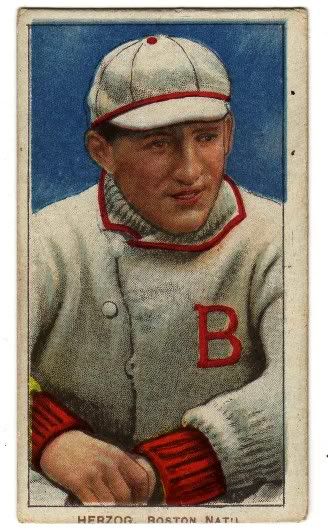 . . . .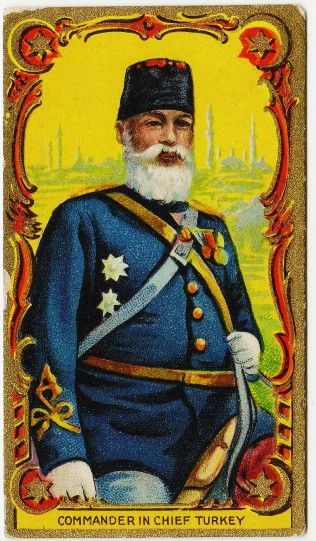 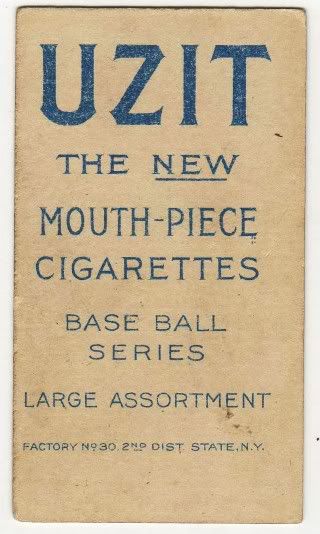 . . . . 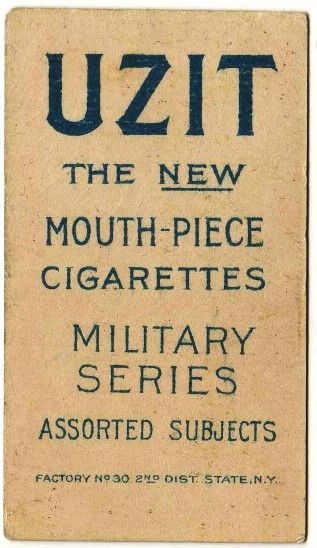 LENOX pack 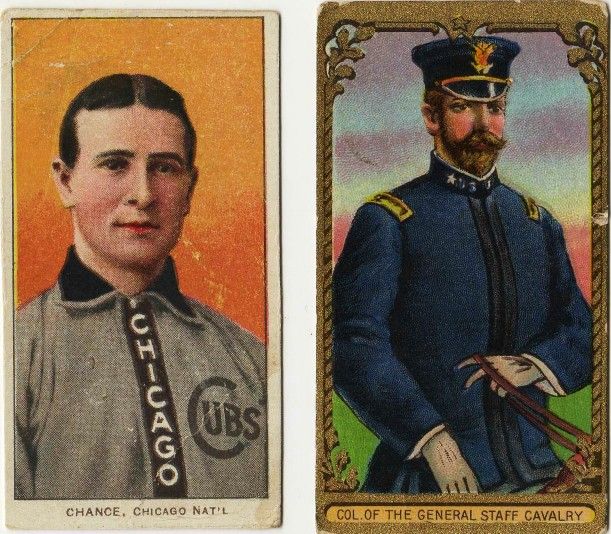 . 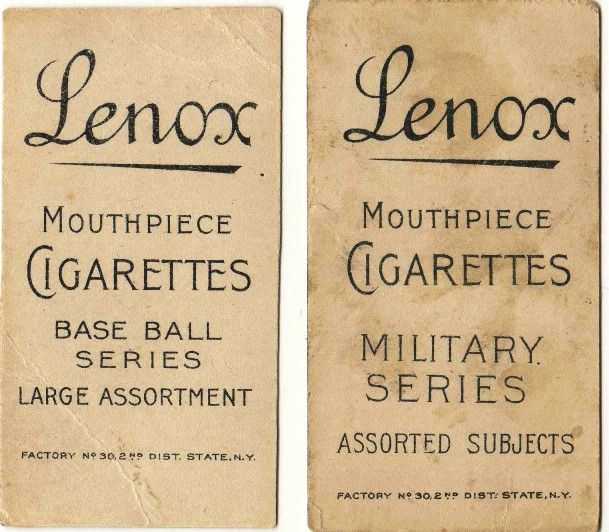 TED Z Last edited by tedzan; 03-26-2013 at 07:20 AM. |
|
#44
|
|||
|
|||
|
here is a good question: could one find a wst transfer of a back, without the overstrike on it or has one been found?
kevin |
|
#45
|
||||
|
||||
|
[QUOTE=tedzan;1108355]With all due repect Clayton...... we have re-hashed this subject many times. The cards were printed at American Lithographic. First the fronts, then the backs. The jobber
would then cut the sheets down to individual cards and he would ship them to the various Tobacco Factory's. We have a well-known American Lithographic ledger document (dated Feb. 1911) that shows us completed cards (front & back) and instructs how the T206's & T80's were to be inserted in the UZIT and LENOX cigarette packs at Factory #30. Furthermore, there are many other examples, such as WET-SHEET imprints of backs on fronts, printer's test proofs with non-sports fronts on T206 backs, etc., etc. And, one of the best examples is Leon's Mullaney with several overprints. Hey Leon....it's time to show your wild looking T206 again. Hi Ted- I guess the part that baffles me is "what was the printing equiptment at the factories used to print?". There's no doubt that the ALC printed fronts and backs, but I've found numerous references to the cards being printed at the factories. We know the ALC did the printing, so~ were these references just based on "mis-information"? Maybe so, but again- what were they printing at the factories? This is why I wonder about the possibility that some of the backs could have been printed at the factories. And, for anyone brand new to this-please keep in mind that I AM NOT saying this AS FACT~ just to be clear- I am just trying to understand what the printing equiptment at the factories was being used for (in a nutshell). Thanks for the response, I appreciate it. Sincerely, Clayton |
|
#46
|
||||
|
||||
|
c'mon Clayton...didn't you read the forum rules? Only Ted is allowed to beat dead horses here?!
|
|
#47
|
|||
|
|||
|
[QUOTE=teetwoohsix;1108534]
Quote:
I'll take a stab at what the factories would have had. More educated guess than anything but having worked in manufacturing plants a lot I figure I've got a good feel for what makes sense. What they would produce were complete packs of cigarettes. The plant would generally be setup for that and not much else. So they would have a machine that would cut and fold the boxes and other cardboard pack materials. And one that would pack the cigarettes in foil inside the pack then wrap and seal it. Foil/pack/product/card/outer label/cellophane/tax stamp. A busy concern might have all those functions built in one machine. A more general producer might have different machines that would allow some easy flexibility in package size. Shipping what would be basically empty boxes assuming slide and shell packages would be silly. If the box was a half inch high two boxes assembed would take about as much space as 25 shipped flat. (very rough calculation based on a guess that the cardboard was about as thick as a modern card.)They'd be shipped flat. Once presses fed by rolls of paper became common the wrappers would be shipped in rolls. The packaging machines either could take a box that wasn't finished and fold and glue it into a box. Typically if the box will be made by the packing machine or a box machine the printing plant will supply them die cut so the flaps are ready to be folded. What they might have printed was the cancellation on the tax stamp that was the last thing applied to the pack. By 1910 the post office was supplying rolls of stamps to companies for use in bulk mailing machines (And vending machines) But the cancels were still largely applied at the post office. Companies like cigarette companies were responsible for cancelling the tax stamps when they were applied. That would be the most likely thing printed by the distribution plant. The process isn't lithography but a form of typography. Usually a metal roller that got inked and then printed the cancel as the stamps ran through the machine. I'm not positive these stamps came in rolls, but it seems likely. I may be able to find out. of the stamps shown at this link, the left one is actually an ATC cancelled stamp from march 1911. http://www.rdhinstl.com/tpd/cigarette.jpg I found this picture of a packing plant, but it's not very good. Very few companies have run a plant of any sort that produced the entire product or nearly the entire product including packaging etc. The only one I know of was Fords River Rouge plant - Ore in cars out. Steve B |
|
#48
|
||||
|
||||
|
Anybody have any thoughts on this question from the first post?
"If they were printed at the same place, then where did the overstrikes come from and how can they be explained? I guess it's possible but I doubt the card backs were printed with the intended distribution factory on the back and then struck again before they left the same place where they were printed." They were printing the backs with factory numbers and then overstriking them there too before they left? |
|
#49
|
||||
|
||||
|
This is really long and likely not interesting to most but here goes.
The 34 SC150F649OP backed subjects look to be, for the most part grouped together for several backs. It would make sense that several of these sheets were selected to be used with F649 packs. At some point were overstruck. The F42s are a bit more complex and very interesting to study. The theory is that some sheets were selected to be F42OP and some F30. At one point 109 SC460F30 cards were printed however only 52 made it into the wild, the rest being overprinted. These 52 are comprised of a base group of 34 cards (these 34 are in every 460 back except for P42). In addition to the 34 any of Teds Exclusive 12 (broken into groups of 6 or smaller) and the 6 super prints could be substituted in to those 34. This allows for several possible combinations of 34. Doubling up the Exclusive 12 into the base could get us the higher percentage that we see making them "Exclusive". That leaves 57 (109-52) original F30s that were at some point overprinted to F42 that never showed up in the wild as F30. Well some did but not in packs  see further down. see further down.This 57 is based on two 28 base groups and a second printing of one swapping out Dougherty with Ames hands above head. 28 + 28 + 1 = 57. Some 460 backs have Ames, some have Dougherty and some have both. Now those 28 base groups in combination with the Exclusive 12 (broken into smaller groups of 6) and the 6 super prints allow for multiple combinations of 34. The Exclusive 12 again could have been doubled up and swapped into the base 28 to get a higher percentage of those 12. These combinations of 34 are found in every 460 back except for Sov 460, which uses the earlier mentioned base of 34+12+6 (identical to SCF30). The theory is that some sheets were selected to be F42OP and some F30. Lucky enough a wonderful thing happened. One sheet of 34 F30 destined to be overprinted, a 28 base group and the 6 super prints was scrapped mid print and never overprinted.....these are known as the yellow brown scraps. Every known example fits into one base group of 28 + 6 superprints. There are 1-3 examples of each, with one having four. This fits into the theory that multiple stacked examples of each card was used. The base 28 yellow browns are special as they have a F30 back that never made it to the overstrike machine, technically ALC never intended them to get out. Pretty cool. And, this is just my theory.
__________________
T206 gallery |
|
#50
|
|||
|
|||
|
Quote:
This OLD MILL scrap with the inverted "Factory #649" overstrike printed on it (indicative of the printer's test) prior to overstriking the Sweet Cap 150 Factory #30 cards should convince you of the fact that the overstrikes were printed at American Litho. The overstrikes were not printed at any Tobacco factory. These factories employed low-paid employees that operated cigarette rolling machinery and in many instances manually stuffed the cigarettes into their packs. 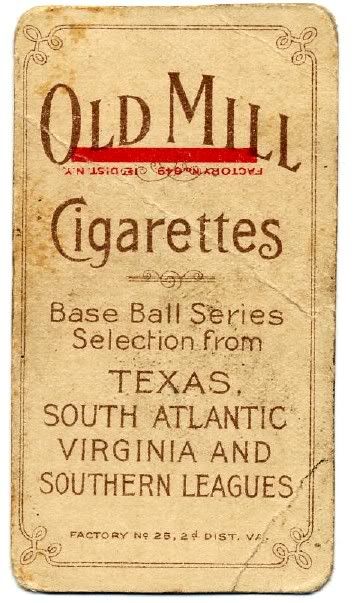 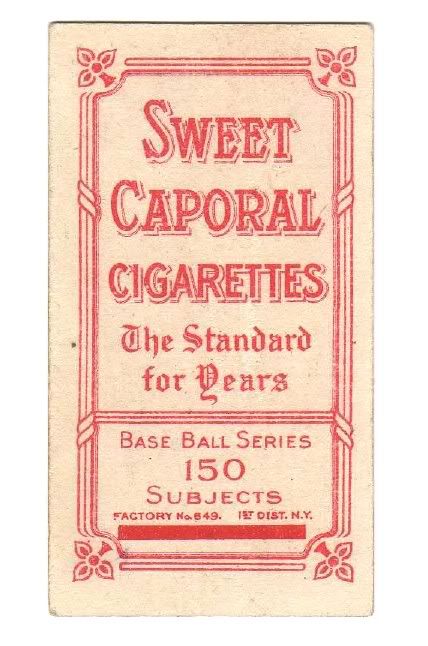 TED Z |
 |
|
|
 Similar Threads
Similar Threads
|
||||
| Thread | Thread Starter | Forum | Replies | Last Post |
| T206's for sale | WabitTwax | Tobacco (T) cards, except T206 B/S/T | 6 | 10-26-2009 09:56 AM |
| Here's some good stuff...can we help? Ryan SL'er T206 | Archive | Net54baseball Vintage (WWII & Older) Baseball Cards & New Member Introductions | 9 | 09-28-2007 04:47 PM |
| T205 and T206 Cards Available | Archive | Tobacco (T) cards, except T206 B/S/T | 0 | 04-06-2007 02:15 PM |
| T206 for sale | Archive | Tobacco (T) cards, except T206 B/S/T | 1 | 02-23-2007 07:21 PM |
| My T206 Plank theory....and, what's your guess ? | Archive | Net54baseball Vintage (WWII & Older) Baseball Cards & New Member Introductions | 112 | 02-08-2007 11:43 AM |